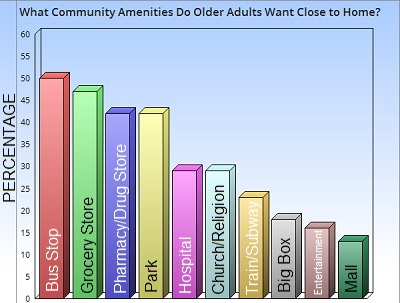AARP offers a Livability Index to drive community focus on independent living.
By Jennifer Castenson
Aging in place gracefully and independently is a huge topic, considering the vast amount of 55-plus individuals who fit into that group on a global level. So huge that Rodney Harrell, PhD, Director of Livability Thought Leadership at AARP and his team developed a Livability Index. He will discuss the topic during his panel on aging in place at the upcoming HIVE conference.
That AARP Livability Index helps a new home buyer look at 60 factors that go into determining the long-term livability of a neighborhood. The vast majority of older adults want to stay in their homes and their long-time communities as they age.
“Actually, in a recent AARP study, the results showed that 71 percent of 50 to 64 year olds want to stay in their homes and their current communities. But communities as we build them often don’t have the options that people need to age well,” said Rodney. “The idea of a livable community is one that has housing, transportation and other options that allow people to stay and thrive in their homes.”
So, how can a buyer find the right place that will work for the long term? The AARP Livability index, available at AARP.org/livabilityindex, was developed as the first and only nationwide neighborhood-based livability index. It covers seven different categories of livability to know how a neighborhood scores on a national average, including housing, neighborhood, transportation, environment, health, engagement and opportunity.
“The features that people want the most are bus stops, grocery stores, pharmacies, and parks,” said Harrell. “All of these things have a direct association to what a community can deliver to help independent living. The idea being that access to transportation gives mobility and access to grocery stores provides healthy foods and access to pharmacies provides medicine and access to parks would be for physical health. So all of it comes back to building a community with options that are not limited to your current status or lifestyle.”
Across the seven categories, the Index evaluates current conditions using a set of 40 metric indicators, and 20 policies and programs that can enhance community livability over time. Harrell will be joining several others at HIVE who have a focus on these matrices and policies, including Sarah Susanka, author, The Not So Big House series; Ryan Frederick, CEO, Smart Living 360; Matthias Hollwich, author, New Aging and principal, Hollwich Kushner; and Ross Chapin, FAIA, Author, The Pocket Neighborhood.
According to that Livability Index, a disparity between what is being built now and what the ideal building is becomes evident. Many recent communities have been built around the automobile. They have cul de sacs that kill space and that also restrict traffic flow. Many people who originally chose those locations because they were ideal in another time in their lives end up staying in them longer than they planned to.
“If you are on that cul de sac and your spouse has passed, your kids live elsewhere and your income is much lower and you are no longer driving, then suddenly that dream house, which wasn’t planned for long term, is isolating,” explained Harrell. “You may no longer be able to access the second floor and the functionality and usefulness of the house is suddenly gone.
“When we look at places through our livability index, some of the most prized communities are very low on livability index for three reasons,” Harrell continued. “First, these neighborhoods score low because they are so homogenous. Their lack of variety of housing options limits the type of homeowners who can live and continue to live there. Next, they are expensive – if your income changes for any reason, you can’t live there. And the third reason is that there are no alternative transportation options.”
The different housing types in a livable community are tailored to different life stages. Harrell avers that communities should offer a two story house to grow a family but then also a single story home or condo to transition into later in life. This would allow someone to stay within the community where they have a network of friends and family. He admits that there isn’t a one-size-fits-all solution, but those options need to be available. A perfect metropolitan area provides a variety of options and not cookie-cutter homes that might lead to isolation.
Income is a major factor in access to many of these resources. Home buyers who make enough money and decide to do so can find a luxury community that has plenty of amenities. Many of these luxury communities add resources that are not necessarily built into the community.
In addition to the fact that most people don’t have those resources, it’s also much more efficient to build communities in a way that allows people to have independence in living, like walking to a grocery store or a pharmacy or public transportation.
Hear more from BUILDER and join the discussion at HIVE – visit www.hwhive.com




